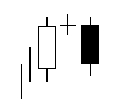👉Patterns definition
About the "Period" parameter in this system: It is used to determine the Downtrend/Uptrend using a Moving Average (learn more here). If you want to skip the trend checking condition, please set the Period to 1. More information about the trend condition of each Pattern, please see Pattern definition here.

Plotting of candlestick charts and analysis of candlestick patterns is an amazing line of technical analysis. The advantage of candlesticks is that they represent data in a way that it is possible to see the momentum within the data.
Candlesticks give a vivid mental picture of trading. After reading and a little practice, candlesticks will be part of your analytical arsenal. Japanese candlestick charts can help you penetrate "inside" of financial markets, which is very difficult to do with other graphical methods. They are equally suitable for all markets.
One of the first analysts who started to predict the movement of prices in the future, based on past prices, was the legendary Japanese Munehisa Homma. Trading principles applied by Homma in trading on the rice market, initiated the technique of Japanese candlesticks, which is now widely used in Japan and abroad.

Figure 1. Structure of a candlestick
Consider the structure of a candlestick (Fig. 1). The rectangle representing the difference between the open and close prices, is called the body of the candlestick. The height of the body represents the range between the open and close prices of the trading period. When the close price is higher than the open price, the candlestick body is white (Fig. 1 a). If the body is black (Fig. 1 b), this means the close price was below the open price.
Candlesticks can have shadows - the upper and lower, the length of shadows depends on the distance between the open/close prices and the minimum/maximum prices.
Candlestick are plotted on the chart one by one, forming various patterns. According to the theory, some patterns can indicate with a certain probability that the trend is changing, or confirm the trend, or show that the market is indecisive.
Long bodies of candlesticks, as a rule, tell about pressure from buyers or sellers (depending on the color of the candlestick). Short bodies mean that the struggle between the bulls and bears was weak.
Candlesticks
Description

"Long Candlesticks". Link to long candlesticks is widespread in the literature on Japanese candlesticks. The term "long" refers to a candlestick body length, the difference between the open price and the close price. It is better to consider the most recent price movements to determine what is long, and what is not. Five or ten previous days - that's quite an adequate period to arrive at a correct conclusion.

"Short Candlesticks". The determination of short candlesticks can be based on the same methodology as in the case of long candlesticks, with similar results. In addition, there are a lot of candlesticks, which do not fall into any of these two categories.

"Marubozu" . In Japanese "Marubozu" means almost bold. In any case, the meaning of the term reflects the fact that the body of the candlestick either does not have up and/or down shadows at all, or they are very small. Black marubozu - a long black body without a shadow on one of the sides. It often becomes a part of the bearish continuation pattern or bull reversal pattern, especially it appears in a downtrend. A long black candlestick indicates a major victory of bears, so it often appears the first day of many reversal patterns of the bullish character. White marubozu - a long white body without a shadow on one of the sides. This is a very strong candle. In contrast to the black marubozu it often turns out to be part of the bullish pattern of continuation or a bearish reversal pattern.

"Doji". If the body of the candlestick is so small that the open and close prices are the same, it is called Doji. The requirement that the open and close prices should be exactly equal, imposes ti strict restrictions on the data, and Doji would appear very rarely. If the price difference between the open and close prices does not exceed a few ticks (minimum price change), this is more than enough.

"Spinning Tops" are short candlesticks with an upper and/or lower shadow longer than the body. Sometimes they are referred to as "white" and "black" Doji. Koma indicates indecision of bulls and bears. The color of the Koma body, as well as the length of its shadow, is not important. The small body relative to the shadows is what makes the spinning top.

"Hanging man" and "Hammer". These are candlesticks with long lower shadows and short bodies. The bodies are at the top of the range of prices. The surprising property of these candlesticks is that they can be bullish and bearish, depending on the phase of the trends, in which they appear. The appearance of these candles in a downward trend is a signal that its dominance in the market is coming to an end, in this case the candlestick is called "the hammer". If the candlestick appears during an uptrend, it indicates its possible end, and the candlestick has an ominous name - "hanging man".

"A start" appears each time when the small body appears whenever a small body opens up or down from the previous long body, body color is unimportant. Ideally, the gap must catch also shadows, but it is not entirely necessary. The star indicates some uncertainty prevailing in the market. Stars are included in many candlestick patterns, mostly reversal.
Table 1. Types of Candlesticks
Separate candlesticks are extremely important for the analysis of combinations of candlesticks. When an analyst uses them separately, and then in combination with other candlesticks, the psychological state of the market is revealed.
2.1. Necessary structures
Candlestick patterns can be a separate candlestick or consist of a few of them. For the candlestick patterns, there are certain rules of recognition.
Example:Evening star (bearish pattern). The trend upwards. The first and third candlesticks are "long". Shadows of the stars are short, the color does not matter. The classical pattern: separation of the star from the Close of the first candlestick, for forex and within the day: Close of the first candlestick and Open of the star are equal. The third candlestick is closed inside the body of the first one.
So first let's learn to recognize the types of candlesticks. For this purpose, we write a function RecognizeCandle, which will recognize the type of candlesticks and return the necessary information.
where:
symbol - the name of the symbol
period – chart period,
time – open time of the candlestick,
aver_period - period of averaging
res - a structure, in which the result is returned.
Let's define what results we need, based on the rules of recognition of candlestick patterns:
open, close, high and low;
open time of the candlestick;
trend direction;
bullish or bearish candlestick;
size of the candlestick body – an absolute value;
type of candlestick (from Table 1).
Let's create a structure:
where trend and type are variables of enumeration type:
Let us consider the RecognizeCandle function.
2.2. Recognition of the candlestick type
First, using the CopyRates function obtain data from previous aver_period +1 candlesticks. Note the order, in which data is stored in the array we obtain.
If data were received without errors, start filling out our return structure CANDLE_STRUCTURE with data.
Defining trend. What is a trend? If this question had a fairly complete answer, the secrets of the market would have been disclosed. In this article we will use the method for determining the trend using a moving average.
MA=(C1+C2+…+Cn)/N, where C – close prices, N – number of bars.
L. Morris in his book "Candlestick Charticng Explained. Timeless techniques for Trading Stocks and Futures" uses to a moving average with a period of ten to identify a short-term trend; if the close price is above average - the trend is up, if lower - it is downward.
That's how it looks like:
Next we define if our candle is bullish or bearish, we calculate the absolute value of the candlestick body, the size of shadows, the average body size of the candlestick during aver_period and other necessary intermediate data.
Now let's deal with the identification of the types of candlesticks.
2.3. Rules of identification of candlestick types
"Long" candlesticks. To define "long" candlesticks, check the value of the current candlestick relative to the average value of aver_period previous candles.
Reference: https://www.candlescanner.com/candlestick-patterns/long-and-short-lines/
Note: incase aver_period=1 (skip trend checking mode) we will use the simple Long/Short candle definition:
- long: body >= 0.65 * (High - Low)
- short: body <= 0.35 * (High - Low)
(Body) > (average body of the last aver_period) *1.3
"Short" candlesticks. To define "short" candlesticks, use the same principle as for the "long" ones, but with a changed condition.
(Body) > (average body of the last X days) *0.5
Doji. Doji occurs when open and close prices are equal. This is a very strict rule. In the case of most types of data, we can tolerate some deviations in finding patterns. The formula allows finding the percentage difference between the two prices within acceptable limits.
(Dodji body) < (range from the highest to the lowest prices) * 0.03
"Marubozu" . This is a candlestick with no high or low, or they are very small
(lower shadow) < (body) * 0.03 or (upper shadow) < (body) * 0.03
When writing an indicator for this article, it was necessary to separate the "long" "Maribozu", for which I had to add the condition for checking "long" candlesticks.
"Hammer" and "Hanging Man". The body is located in the upper part of the daily range and the lower shadow is much longer than the body. It is also necessary to consider the length of the upper shadow, if there is any. The ratio between the body and the lower shadow is defined as the ratio of the body length to the length of the lower shadow:
(lower shadow)>(body)*2 and (upper shadow)< (body)*0.1
"Shooting Star" and "Inverted Hammer" are similar to the "Hammer", but with the opposite condition:
(lower shadow)<(body)*0.1 and (upper shadow)> (body)*2
"Spinning Tops". These are "short" candlesticks" with shadows longer than the body:
Short candle and (lower shadow) > (body) and (upper shadow) > (body)
The source text of the function and structure descriptions are in the attached file CandlestickType.mqh.
A;so to the article, the Candlestick Type Color.mq5 indicator is attached, which paints candlesticks on the chart depending on their type.

Figure 2. Example of Candlestick Type Color.mq5
So we have created a function that returns all the necessary data.
Now we cane proceed creating an indicator that will recognize candlestick patterns.
3. Candlestick Patterns and Algorithms for Their Identification
A candlestick pattern can be either a single candlestick, or consist of several candlesticks, seldom more than five or six. In Japanese literature, they sometimes refer to the patterns consisting of a larger number of candlesticks. The order in which we will consider the patterns, does not reflect their importance or predictive capabilities.
Candlestick patterns are divided into two types - reversal patterns and continuation patterns.
We will consider simple patterns (one candlestick) first, and then complex (several candlesticks). The figure containing the pattern will start with two small vertical lines. These lines simply indicate the direction of the previous trend of the market, and should not be used as a direct indication of the relations between patterns.
The patterns will be presented in a table, in the first line - bull pattern, in the second - the opposite bearish pattern, if there is such.
3.1. REVERSAL PATTERNS OF CANDLESTICKS
3.1.1. Patterns consisting of a single candlestick
Obtain data for a single candlestick:
and recognize patterns.
Inverted hammer (bullish)
Buy


Downward trend. The upper shadow is not less than 2 and no more than 3 times larger than the body. There is no lower shadow, or it is very short (no more than 10% of the candlestick range). The color of the body in the long game is not important, with the short - white hammer is much stronger than the black one. Confirmation is suggested.
Hanging Man (bearish)
Sell
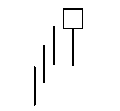

Uptrend. The lower shadow is not less than 2 and no more than 3 times larger than the body. There is no upper shadow, or it is very short (no more than 10% of the candlestick range). The color of the body in the long game is not important, with the short - the black hanging man is much stronger than the white one. Confirmation is suggested.
Hammer (bullish)
Buy
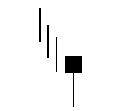

Downward trend. The lower shadow is not less than 2 and no more than 3 times larger than the body. There is no upper shadow, or it is very short (no more than 10% of the candlestick range). The color of the body in the long game is not important, with the short - white hammer is much stronger than the black one. Confirmation is suggested.
Shooting Star (bearish)
Sell

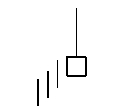
Uptrend. The upper shadow is not less than 3 times is larger than the body. There is no lower shadow, or it is very short (no more than 10% of the candlestick range). The price gap between the star and the previous candlestick. Forex: the Close price of the previous candlestick and Open of the Star are equal. The body color does not matter. Confirmation is suggested.
I would like to draw your attention to the fact that in the case of "Shooting Star" we actually need two candlesticks, because under the terms of recognizing the body of the previous day is taken into account.
Belt Hold (bullish)
Buy
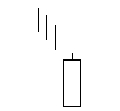
The pattern is not implemented
Downward trend. Opening of a candlestick with a large gap in the direction of the trend. White candlestick — «marubozu» «long». The body of the white candlestick is much larger than the body of the previous candlestick. Confirmation is suggested.
Belt Hold (bearish)
Sell
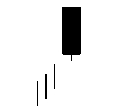
The pattern is not implemented
Uptrend. Opening of a candlestick with a large gap in the direction of the trend. Black candlestick — «marubozu» «long». The body of the black candlestick is much larger than the body of the previous candlestick. Confirmation is suggested.
Like in the case with the "Shooting Star", two candlesticks are used, because the body of the previous day is taken into account for pattern recognition.
3.1.2. Patterns consisting of two candlesticks
Add another candle:
and recognize patterns:
Engulfing (bullish)
Buy
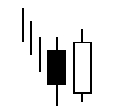

Downward trend. The body of the second candlestick completely covers the body of the first one. Forex: Close of the black candlestick and Open of the white one match. Shadows do not matter. Confirmation is suggested.
Engulfing (bearish)
Sell


Uptrend. The body of the second candlestick completely covers the body of the first one. Forex: Close of the white candlestick and Open of the black one match. Shadows do not matter. Confirmation is suggested.
Harami Cross (Bull)
Buy

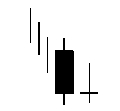
Downward trend. The first candlestick of the pattern is long black. Doji is within the range of the first candlestick, including the shades. Forex: doji is on the level of Close of the first candlestick. If Doji shadows are short, the pattern should be considered a Doji Star for forex. Confirmation is suggested.
Harami Cross (bearish)
Sell
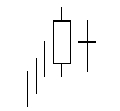

Uptrend. The first candlestick of the pattern is long white. Doji is within the range of the first candlestick, including the shades. Forex: doji is on the level of Close of the first candlestick. If Doji shadows are short, the pattern should be considered a Doji Star for forex. Confirmation is suggested.
Harami (bullish)
Buy
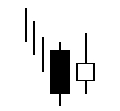
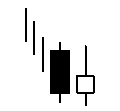
Downward trend. The body of the first "long" candlestick" completely engulfs the body of the second one. Shadows do not matter. Forex: Close of the black candlestick and Open of white match. Confirmation is suggested.
Harami (bearish)
Sell
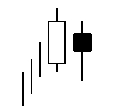

Uptrend. The body of the first "long" candlestick" completely engulfs the body of the second one. Shadows do not matter. Forex: Close of the white candlestick and Open of black match. Confirmation is suggested.
Doji Star (bullish)
Buy
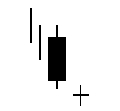

Downward trend. The first candlestick of the pattern is long black. The second session - doji with a break in the trend direction. Forex: no break. Shadows of doji are short. Confirmation is suggested.
Doji Star (bearish)
Sell

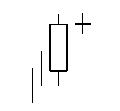
Uptrend. The first candlestick of the pattern is long white. The second session - doji with a break in the trend direction. Forex: no break. Shadows of doji are short. Confirmation is suggested.
Piercing Pattern (bullish)
Buy


Downward trend. Both candlesticks are long. Open of the white candlestick is below Low of the black. Forex: Close of the black candlestick and Open of white are equal. The white candlestick is closed inside the black one and covers more than 50% of the body. (For stock markets: unlike Dark-cloud cover, this requirement has no exceptions.) Confirmation is not required for the classical model, is required for Forex.
Dark Cloud Cover (Bear)
Sell

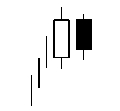
Uptrend. Both candlesticks are long. Open of the black candlestick is above High of the white candlestick. Forex: Close of the white candlestick and Open of black are equal. The black candle closes inside white and covers more than 50% of the body. Confirmation is not required for the classical model, is required for Forex.
Meeting Lines (bullish)
Buy

The pattern is not implemented
Downward trend. The first candlestick of the pattern is long black. Open of the white candlestick is with a large gap and is below the Low of the black candlestick. Close prices of both candlesticks are the same. Confirmation is suggested.
Meeting Lines (bearish)
Sell

The pattern is not implemented
Uptrend. The first candlestick of the pattern is long white. Open of the black candlestick is with a large gap and is above the High of the white candlestick. Close prices of both candlesticks are the same. Confirmation is suggested.
Matching Low (bullish)
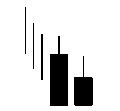
The pattern is not implemented
Downward trend. The first candlestick of the pattern is long black and the second is black. Open of the second candlestick is inside the body of the first one. Close prices of both prices are the same. there are no lower shadows or they are very short. Confirmation is suggested.
Homing Pigeon<br1(bullish) Bullish Homing Pigeon
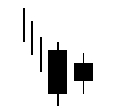
The pattern is not implemented
Downward trend. The first candlestick of the pattern is long black and the second is black. The body of second candlestick is inside the body of the first one. there are no lower shadows or they are very short. Confirmation is suggested.
3.1.3. Patterns consisting of three candlesticks
Abandoned Baby (bullish)

The pattern is not implemented
This is a rare but important reversal pattern. Downward trend. The first candlestick of the pattern is long black. The second candlestick is doji with a gap, and the gap is not only between the candlestick bodies, but also between shadows. The third candlestick is "long" white candlestick with the same gap between the shadows and Close inside the body of the first candlestick.
Abandoned Baby (bearish)

The pattern is not implemented
This is a rare but important reversal pattern. Uptrend. The first candlestick of the pattern is long white. The second candlestick is doji with a gap, and the gap is not only between the candlestick bodies, but also between shadows. The third candlestick is "long" black candlestick with the same gap between the shadows and Close inside the body of the first candlestick.
Morning Star (bullish)
Buy
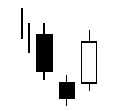
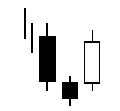
Downward trend. The first and the third sessions are "long" candlesticks. Shadows of the stars are short, the color does not matter. Separation of the star from the Close of the first candlestick. Forex: Close of the first candlestick and Open of the star are equal. The third candlestick is closed inside the body of the first one.
Evening Star (bearish)


Uptrend. The first and the third sessions are "long" candlesticks. Shadows of the stars are short, the color does not matter. Separation of the star from the Close of the first candlestick. Forex: Close of the first candlestick and Open of the star are equal. The third candlestick is closed inside the body of the first one.
Morning Doji Star (bullish)
Buy

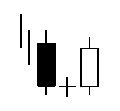
Downward trend. The first candlestick of the pattern is long black. The second session - doji with a break in the trend direction. Forex: no break. Shadows of doji are short. The third candlestick is closed inside the body of the first one.
Bearish Upside Gap Two Crows
Sell
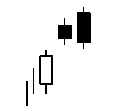
The pattern is not implemented
Uptrend. The first candlestick is "long" white. A gap between white and black candlesticks. The third candlestick opens higher than the second and engulfs it. Confirmation is suggested. The meaning of the pattern: if prices could not go up during the 4th session, we should expect prices to fall.
Two Crows (bearish)
Sell

The pattern is not implemented
Uptrend. The first candlestick of the pattern is long white. The gap between white and the first black candlestick. The third candlestick is black and necessarily "long"; opens inside or above the second and closes within or below the white candlestick, covering the gap. Confirmation is suggested. If the second crow (the third candle) engulfs a white candle, the confirmation is not required.
Three Star in the South (bullish)
Buy
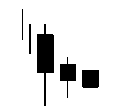
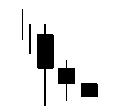
Downward trend. The first candlestick is a long black day with a long lower shadow. The second candlestick is shorter than the first, its Low is above the Low of the first candlestick. The third candlestick is a small black marubozu or a star, an internal day in relation to the second session. Confirmation is suggested.
Deliberation (bearish)

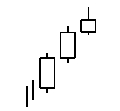
Uptrend. Three white candlesticks with higher close prices. The first two candlesticks are long days. Open price of each candlestick is inside the body of the preceding one. Forex: open/close prices of white candlesticks are the same. The third candlestick opens at about the close level of the second candlestick. the third candlestick is a star or a spinning top. Confirmation is suggested.
Three White Soldiers (bullish)
Buy


Downward trend. Three long white candlesticks appear one after another, close prices of each of them is higher than that of the previous. Open price of each soldier is inside the body of the previous candlestick. Forex: Close/Open of solders are the same. Upper shadows of the soldiers are short. Confirmation is not required.
Three Black Crows (bearish)

The pattern is not implemented
Uptrend. Three long black candlesticks appear one after another, close prices of each of them is lower than that of the previous. Open price of each crow is inside the body of the previous candlestick. Forex: corresponds to pattern Identical three crows. The lower shadows of the crows are short. Confirmation is not required.
Three Outside Up (bullish)
Buy


Downward trend. First the pattern of Engulfing (bull) is formed: the body of the second candlestick completely covers the body of the first one. Forex: Close of a black candlestick and Open of the white one are equal. Shadows do not matter. Then, on the third day there is a higher close. Confirmation is not required: the pattern itself is a confirmation to the bull Engulfing
Three Outside Down (bearish)
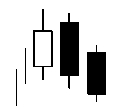

Uptrend. First the pattern of Engulfing (bear) is formed: the body of the second candlestick completely covers the body of the first one. Forex: Close of the white candlestick and Open of the first black one match. Shadows do not matter. Then, on the third day there is a lower close. Confirmation is not required: the pattern itself is a confirmation to the bear Engulfing
Three Inside Up (bullish)
Buy


Downward trend. In the first two sessions the Harami (bull) pattern is formed: a small white body is engulfed by a large black one. Close in the third session is higher than High of the first two candlesticks. Confirmation is not required: the pattern itself is a confirmation to the bull Harami.
Three Inside Down (bearish)


Uptrend. In the first two sessions the Harami (bear) pattern is formed: a small black body is engulfed by a large white one. Close in the third session is lower than Low of the first two candlesticks. Confirmation is not required: the pattern itself is a confirmation to the bear Harami.
Three Stars (bullish)
Buy
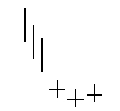

Downward trend. The gap between the first doji and previous candlesticks is not required. All the three candlesticks are doji. The middle doji has a gap up or down. Forex: all the three doji are on one level. Confirmation is suggested.
Identical Three Crows (bearish)
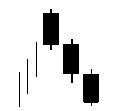

Uptrend. Three long black candlesticks appear one after another, close prices of each of them is lower than that of the previous. The open price of each crow is approximately equal to Close of the preceding candlestick. The lower shadows of the crows are short. Confirmation is not required.
Unique Three River Bottom (bullish)

The pattern is not implemented
Downward trend. The first candlestick of the model is a long black with short shadows. On the second day Harami appears, but with a black body. The lower shadow of the second day gives a new Low. The third day is a short white day lower than the middle day. Confirmation is not necessary but desirable.
3.1.4. Patterns consisting of four candlesticks
Concealing Baby Swallow (bull)

The pattern is not implemented
Downward trend. The first two sessions are two long black marubozu. The third session opens with a break down, but trade is conducted inside the body of the second candlestick, which leads to the formation of a long upper shadow. The fourth black candlestick completely engulfs the third one, including the shadow. Confirmation is not required.
3.1.5. Patterns consisting of two candlesticks
Breakaway (bullish)
Buy

The pattern is not implemented
Downward trend. The first two sessions — a "long" black candlestick and a "short" black candlestick (star) with a gap. The third session is "short", can be of any color. The fourth candlestick is "Short" black. The fifth one is "long" white with Close inside the gap. Confirmation is suggested.
Breakaway (bearish)
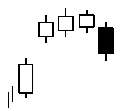
The pattern is not implemented
Uptrend. The first two sessions — a "long" white candlestick and a "short" white candlestick (star) with a gap. The third session is a "short" candlestick, can be of any color. The fourth day is "short" white. The fifth one is "long" black with Close inside the gap. Confirmation is suggested.
3.2. CONTINUATION PATTERNS
Continuation patterns are the time when the market is resting.
Whatever the model, you need to make a decision about your current position, even if it is to change nothing.
3.2.1. Patterns consisting of a single candlestick
Kicking (bullish)
Buy

The pattern is not implemented
The long black "marubozu" is followed by the long white "marubozu". There is a gap between the bodies. Confirmation is not required.
3.2.2. Patterns consisting of two candlesticks
Bearish On Neck Line
Sell

The pattern is not implemented
Downward trend. The first candlestick of the pattern is long black. The white candlestick open below Low of the black one and closes at about Low of the black candlestick. The white candlestick - not necessarily a long day. Confirmation is suggested.
In Neck Line (bearish)
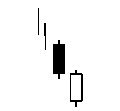
The pattern is not implemented
Downward trend. The first candlestick of the pattern is long black. The white candlestick opens below Low of the black one and closes a little higher than Close of the black candlestick. The white candlestick - not necessarily a long day. The body of the white candlestick is smaller than the body of the black candlestick. The upper shadow of the white candlestick is very small. Confirmation is suggested.
Thrusting Line (bearish)

The pattern is not implemented
Downward trend. The first candlestick of the pattern is long black. The white candlestick opens below Low of the black one and closes a higher than Close of the black candlestick, but the close price is still below the middle of the black candlestick. The white candlestick - not necessarily a long day. Confirmation is suggested.
These three models have much in common, so their implementation is somewhat different, please pay attention to it.
3.2.3. Patterns consisting of three candlesticks
Upside Gap Three Methods (bullish)
Buy
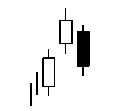
The pattern is not implemented
Uptrend. The first two candlesticks are two "long" white candlesticks with a gap. The third candlestick opens inside the body of the second and fills in the gap. Confirmation is suggested.
Upside Gap Three Methods (bearish)
Sell

The pattern is not implemented
Downward trend. The first two candlesticks are two "long" black candlesticks with a gap. The third candlestick opens inside the body of the second and fills in the gap. Confirmation is suggested.
Upside Tasuki Gap (bullish)
Buy
 <
<
The pattern is not implemented
Uptrend. The gap between two neighboring white candles. White candlesticks are not necessarily "long". The third session opens within the body of the second candlestick. The third session closes inside the gap, but the gap is partially unfilled. Confirmation is suggested.
Downside Tasuki Gap (bearish)
Sell

The pattern is not implemented
Downward trend. The gap between two neighboring black candles. Black candlesticks are not necessarily "long". The third session opens within the body of the second candlestick. The third session closes inside the gap, but the gap is partially unfilled. Confirmation is suggested.
3.2.4. Patterns consisting of four candlesticks
Three-Line Strike (bullish)
Buy


The bullish trend is continuing with three candlesticks, similar to the Three white soldiers pattern: long white candlesticks with short shadows. Forex: Open/close prices of white candlesticks are the same. The fourth candlestick opens with a gap up and closes below open of the first white candlestick. Forex: close of 3rd and open of 4tha candlesticks are equal. Confirmation is suggested.
Three-Line Strike (bearish)
Sell
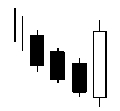
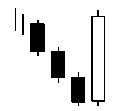
The bearish trend is continuing with three candlesticks, similar to the Three black crows pattern: long black candlesticks with short shadows. Forex: Open/close prices of black candlesticks are the same (similar to Identical three crows). The fourth candlestick opens with a gap down and closes above open of the first black candlestick. Forex: close of 3rd and open of 4tha candlesticks are equal. Confirmation is suggested.
4. The implementation of the indicator
Let's select required input parameters.
Figure 3. Input parameters of the Candlestick Patterns indicator
The first parameter is the "Averaging period" - we need it for determining trend direction, defining "long" and "short" candlesticks.
The next parameter is "Enable signal" - responsible for enabling/disabling the signal. The signal notifies that anew pattern has appeared.
Figure 4. Signals generated by the Candlestick Patterns indicator
Parameter "Number of bars for calculation" is designed to facilitate the work of the indicator. If its value is less or equal to 0 candlestick patterns are searched through the entire available history, otherwise a set number of bars is used for search, which considerably facilitates the work of the indicator.
I think everything is clear with colors...
"Enable comments" means enable/disable names of candlestick patterns.
"Font size" sets the font size for comments.
The implementation of the indicator is very simple.
Expect the appearance of a new bar:
Then we calculate the initial value of the counter to start the cycle.
In the loop we check the combinations of candlesticks and display them as it shown in Fig. 5:
Combination with one candlestick: an arrow with the pattern name above or below it.
Combination with two candlesticks: a thin rectangle with the pattern name above or below the first candlestick.
Combination with three or more candlesticks: a thick rectangle with the pattern name above or below the last candlestick.

Figure 5. Example of how the Candlestick Patterns indicator works
Please note that due to the possibility of function overloading, the output of signs of different patterns is done via the functions with the same name DrawSignal(), but with different numbers of parameters.
The full text of the indicator is in the file Candlestick_Patterns.mq5 attached to this article.
Conclusion
In this article we have reviewed most of the candlestick patterns, methods of detecting them and provided examples of how to implement them in the MQL5 programming language. The attachment to the article contains two indicators and an include file. To use them, place indicators in the \Indicators folder and include file in \Include folder, then compile them.
I hope that the analysis of candlestick patterns will help you improve the results of your work.
Looking ahead, I'd like to add that filtered out candlesticks give better results than most of technical indicators, but we will consider this subject in the following article, in which I am going to create a trading system and an Expert Advisor trading by the candlestick patterns.
Last updated
Was this helpful?

